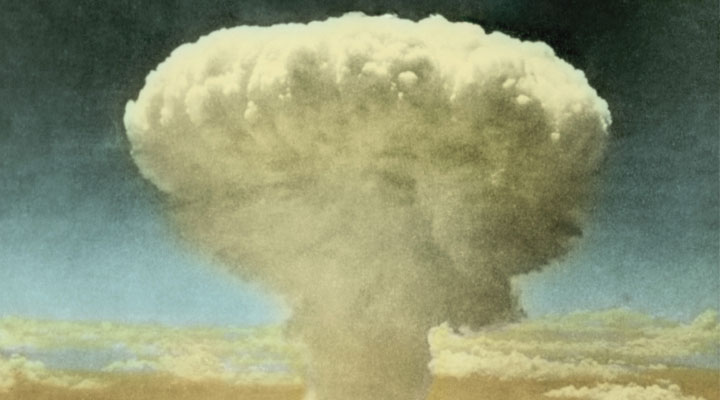(单词翻译:单击)
听力文本
Welcome to THE MAKING OF A NATION – American history in VOA Special English. I'm Steve Ember. This week, we continue our series of "time capsule" programs, each one exploring another facet, decade or period of America in the twentieth century. This week, science brings an end to World War Two and lays the groundwork for a new attention to research, development, and scientific education in the years to come. World War Two ended with an action that was never taken before in the history of warfare, and has never been taken since. It required the efforts of a team of scientists. Working in secrecy, they designed and built the first atomic bombs. President Harry S. Truman made the decision to use these weapons against Japan in August of nineteen forty-five.
"The world will note that the first atomic bomb was dropped on Hiroshima. We shall continue to use it until we destroy Japan's power to make war." America's use of atomic weapons brought years of conflict in Europe and the Pacific to an end. But it also marked the beginning of the nuclear age. And it represented, in a dramatic way, the growing importance of science and technology in modern times. Interest in science goes back to the earliest days of the nation. President Thomas Jefferson and Benjamin Franklin were famous not only as political leaders but also as inventors and scientists. President Abraham Lincoln and Congress established the National Academy of Sciences during the Civil War in the eighteen sixties.
And in the early nineteen hundreds, the nation created scientific offices to study and improve agriculture, public health, even air travel. By the start of World War One in nineteen fourteen, the federal government was employing scientists in many areas of work. President Woodrow Wilson created the National Research Council to organize the work of scientists and engineers to win the war. However, before World War Two, government support for science was generally limited. The government was willing to pay for research only to meet certain clear goals, such as better weapons or military transport systems. World War Two greatly changed the traditionally limited relationship between American scientists and the federal government. In the early years of the war, the German forces of Adolf Hitler showed the world the power of their new tanks, guns and other weapons.

President Franklin Roosevelt knew that the United States would need to develop modern weapons of its own if it entered the war. For this reason, Roosevelt established a National Defense Research Committee in nineteen forty to support and organize research on weapons. The new committee included some of the top scientists in America. Among its members were the presidents of Harvard University, the Massachusetts Institute of Technology and Bell Laboratories. The committee did its work so well that Roosevelt later formed an even more powerful Office of Scientific Research and Development. The leader of both groups was Vannevar Bush -- no relation to the future presidents. He had long experience as a professor of electrical engineering and as an inventor. Many scientists knew him.
Vannevar Bush put together a hard-working team. And in the years that followed, American scientists and engineers developed one invention after another to help the war effort. Scientists developed new devices to help the Navy find German submarines. They improved methods for bombers to find their targets. And they developed more powerful rockets to protect American troops when they landed on foreign beaches. American scientists and doctors also made great progress in improving the methods of wartime medicine. World War Two may well have been the first war in history in which a wounded soldier was more likely to survive than to die. But, in many ways, the most important scientific development of the period was the atomic bomb.
In nineteen thirty-nine, Albert Einstein wrote President Roosevelt a letter. The scientist told the president that it might soon be possible to build a powerful weapon -- a weapon that would use the power of the atom. And he urged Roosevelt to get American scientists to build the atomic bomb before German scientists could build one. Roosevelt agreed. He created a special team of scientists. Their work became known as the Manhattan Project. Roosevelt made sure that these scientists got all the money and supplies they needed. Roosevelt died before the scientists could complete their work.
重点解析
1.bring an end to 终止;结束某事
Neutral state in the area has tried to bring an end to the war.
该地区的中立国为结束战争作出了努力。
2.make the decision 下决心;作出决定
His position entitled him to make the decision by himself.
他的地位使他有权利做那个决定。
3.be willing to 愿意;乐于
You must be willing to reskill.
你必须乐于学习新技术。
4.put together 把……放在一起;加在一起
We'll put together a proposal, including detailed costings, free of charge.
我们将免费拟一份提案,其中包括详细的成本估算。
参考译文
欢迎收听VOA慢速英语之建国史话节目,我是史蒂夫·恩伯。本周,我们继续“时间胶囊”系列节目,每期节目都将探索美国在20世纪的一个方面,或十年,或一个时期。本周,科学为第二次世界大战画上句号,并为未来几年对研究、发展和科学教育的新关注奠定了基础。第二次世界大战以一个在战争史上从未采取过的行动而结束,从那以后就再也没使用过。这需要一组科学家的努力,他们秘密工作,设计并制造了第一颗原子弹。1945年8月,美国总统杜鲁门决定对日本使用这些武器。
“全世界都会注意到第一颗原子弹是在广岛投下的,我们将继续使用它,直到摧毁日本发动战争的力量。”美国使用原子武器结束了欧洲和太平洋地区多年的冲突,但它也标志着核时代的开始,它以一种戏剧性的方式代表了科学技术在现代日益重要的地位。杰明·富兰克林不仅以政治领袖的身份闻名,而且还是著名的发明家和科学家。亚伯拉罕·林肯总统和国会在18世纪60年代南北战争期间,建立了国家科学院。
19世纪初,美国建立了科学办公室来研究和改善农业、公共卫生,甚至航空旅行。到1914年第一次世界大战开始时,联邦政府在许多领域雇用科学家。伍德罗·威尔逊总统创建了国家研究委员会,组织科学家和工程师的工作,以赢得这场战争。然而,在第二次世界大战之前,政府对科学的支持通常很有限。政府只愿意为实现某些明确的目标,如更好的武器或军事运输系统而支付研究费用。第二次世界大战极大地改变了美国科学家与联邦政府之间传统上有限的关系。战争初期,阿道夫·希特勒领导的德国军队向世界展示了他们新坦克、枪支和其他武器的威力。
富兰克林·罗斯福总统知道,如果美国参战,就需要发展自己的现代武器。为此,罗斯福在1940年成立了一个国防研究委员会,以支持和组织武器研究。新委员会包括一些美国顶尖的科学家,其成员中有哈佛大学、麻省理工学院和贝尔实验室的校长。委员会运作良好,罗斯福后来成立了一个更强大的科学研发办公室。这两个组织的领导人都是瓦内瓦尔·布什——他与未来的布什总统没有任何关系。他一直都是一位电气工程教授和发明家,许多科学家都认识他。
瓦内瓦尔·布什组建了一支勤奋工作的团队。在随后的几年里,美国的科学家和工程师研制出一项又一项的发明来援助战争。科学家们开发了新型设备帮助海军找到德国潜艇,他们改进了轰炸机寻找目标的方法,还研制出更强大的火箭来保护登陆境外海滩的美军。美国科学家和医生在改进战时医疗方法方面也取得了很大进展。第二次世界大战很可能是历史上第一次,受伤士兵生还几率大于死亡几率的战争。但是,在许多方面,这一时期最重要的科学发展是原子弹。
1939年,阿尔伯特·爱因斯坦给罗斯福总统写了一封信。这位科学家告诉总统,很快就有可能制造出一种强大的武器——一种利用原子能的武器。他敦促罗斯福让美国科学家在德国科学家研制成功之前制造出原子弹。罗斯福同意了,他创建了一支特殊的科学家队伍,他们的工作被称为曼哈顿计划。罗斯福确保这些科学家得到所需的所有资金和物资。罗斯福在科学家们完成他们的工作之前就去世了。
译文为可可英语翻译,未经授权请勿转载!


